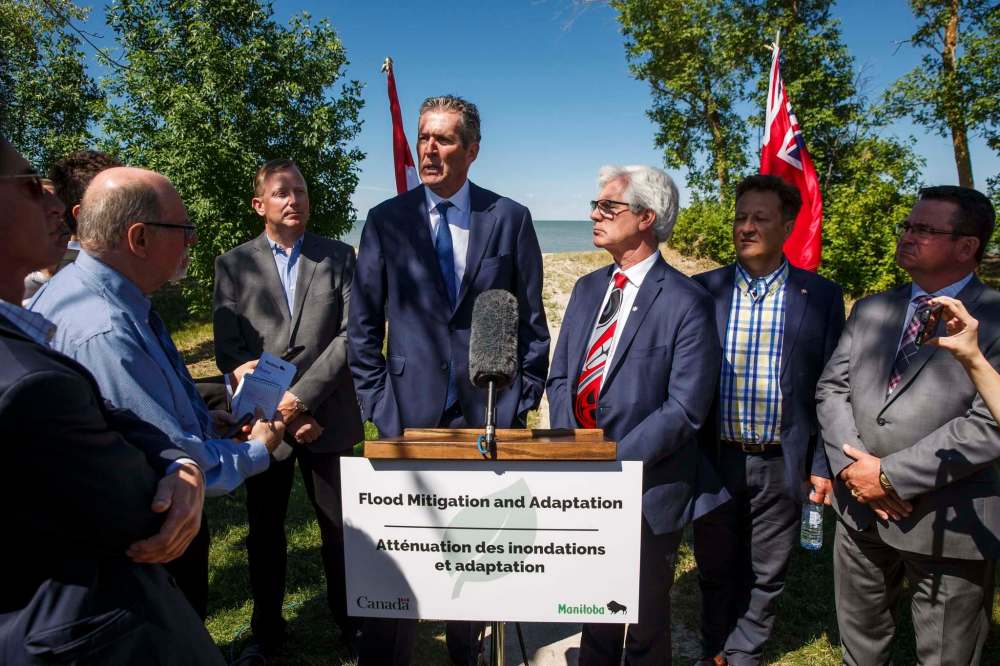Federal-provincial co-operation produces flood-relief results
Read this article for free:
or
Already have an account? Log in here »
To continue reading, please subscribe:
Monthly Digital Subscription
$0 for the first 4 weeks*
- Enjoy unlimited reading on winnipegfreepress.com
- Read the E-Edition, our digital replica newspaper
- Access News Break, our award-winning app
- Play interactive puzzles
*No charge for 4 weeks then price increases to the regular rate of $19.00 plus GST every four weeks. Offer available to new and qualified returning subscribers only. Cancel any time.
Monthly Digital Subscription
$4.75/week*
- Enjoy unlimited reading on winnipegfreepress.com
- Read the E-Edition, our digital replica newspaper
- Access News Break, our award-winning app
- Play interactive puzzles
*Billed as $19 plus GST every four weeks. Cancel any time.
To continue reading, please subscribe:
Add Free Press access to your Brandon Sun subscription for only an additional
$1 for the first 4 weeks*
*Your next subscription payment will increase by $1.00 and you will be charged $16.99 plus GST for four weeks. After four weeks, your payment will increase to $23.99 plus GST every four weeks.
Read unlimited articles for free today:
or
Already have an account? Log in here »
Hey there, time traveller!
This article was published 19/06/2018 (2733 days ago), so information in it may no longer be current.
Given the frequently strained relationship between Ottawa and Manitoba’s Progressive Conservative government during the past two years, it’s refreshing to be able to applaud both for putting aside their differences in support of an urgent cause.
The chronic flooding that has ravaged communities surrounding Lake St. Martin and Lake Manitoba has defied conventional solutions. Triggered in part by water sent north from the Portage Diversion — necessary to protect Winnipeg and the communities along the Lower Assiniboine River — annual spring flooding in this area has forced farmers and First Nations people surrounding the two lakes to endure decades of destruction and disruption. And now, finally, a solution.
The expansion of an existing outlet at Lake St. Martin and construction of a second, new outlet on Lake Manitoba will drain surplus water from the two lakes and, it is hoped, protect previously flood-affected communities in the future.

However, the project will cost $540 million. An undertaking of such magnitude needs to be cost-shared, and cost-shared it has become.
After months of negotiation, Ottawa will contribute $247.5 million, with the province providing the remaining $292.5 million. The federal contribution will come from a $2-billion fund created to help provinces pay for infrastructure necessary to mitigate the impact of floods, fires and storms. That means it will not affect other federal infrastructure money coming to Manitoba.If a province the size of Manitoba was forced to use its regular federal infrastructure funding to build these flood channels, it would mean a massive reduction in the number of roads, bridges and water treatment projects.
The significance of this funding agreement cannot be overstated. Manitoba asked for special consideration for its flood-channel project, and Ottawa agreed. That may seem like a simple achievement, but it is not.
Provinces are constantly sparring with the federal government over cost-sharing of projects and programs, with the former trying to get as much additional money as it can and the latter trying to avoid setting a precedent in one province that may trigger a similar request in another. It involves political horse-trading at the highest levels of governments, with billions of dollars at stake.
This tug of war is particularly difficult when large-scale infrastructure projects are involved. If a province the size of Manitoba was forced to use its regular federal infrastructure funding to build these flood channels, it would mean a massive reduction in the number of roads, bridges and water treatment projects.
In this case, Manitoba was insistent that Ottawa participate in the Lake Manitoba and Lake St. Martin projects with money outside normal infrastructure funding. Although there were some tense moments when it looked like the deal would not come to fruition, Ottawa eventually agreed. Kudos to both.
This is not, however, a new phenomenon. A similar scenario was faced by former NDP premier Gary Doer, who wanted federal money for both the Canadian Museum for Human Rights and a huge expansion of the Red River Floodway, without draining money from core, cost-shared infrastructure projects that are essential for local government.Manitoba and Ottawa have not always seen eye to eye. It might even be said that over the past two years, they have found precious few subjects on which they agree. However, on this file, reason seems to have ruled the day.
The negotiations spanned three prime ministers and two governments, and several times looked as if they would fall apart. But in the end, an agreement was reached. Both the floodway expansion and museum came to fruition without having to take a decade-long pause on other core infrastructure needs.
Manitoba and Ottawa have not always seen eye to eye. It might even be said that over the past two years, they have found precious few subjects on which they agree.
However, on this file, reason seems to have ruled the day. The Lake Manitoba-Lake St. Martin project is proof that politicians can, occasionally, find a way to come together to do the right thing for the right reasons.








